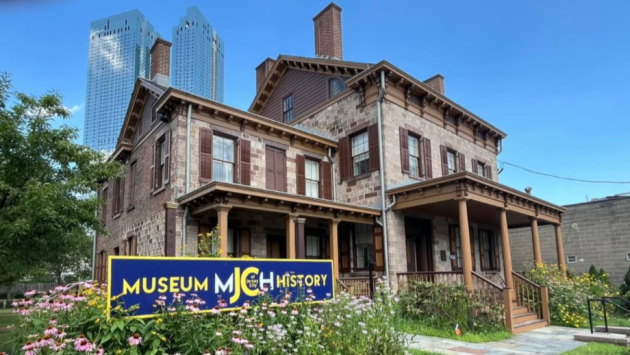Jersey City Times: The Palatial Gym Where a Jersey City Olympic Gold Medalist Once Trained
- Museum Jersey City History
- Aug 22
- 4 min read
This is the seventh in a weekly series of essays on Jersey City’s illustrious sports history. It complements the Museum of Jersey City History’s current exhibit Legendary Arenas… and the Legends Who Performed There at the Apple Tree House (298 Academy Street). The exhibit is open to the public on Wednesdays and Saturdays from 1:00 to 5:00 pm. until October 15.
by Peter Begans
August 22, 2025

The pastor of Jersey City’s First Congregational Church had a revolutionary idea: “To counteract the evil effects of the saloon and to keep young men and boys from the gin mill and grog shop by providing them a place where they will have healthful and interesting amusements.” (NYT 11/10/1891) Financed by metropolitan-area philanthropists, Rev. John L. Scudder created a facility at Grand and Henderson (now Marin) that he called the “People’s Palace.” It was modeled after London’s institution of the same name, and he opened it to all boys, not just those of his parish.

People’s Palace was an instant success. Five hundred boys signed up immediately, paying a penny a day for the right to bowl, play billiards, and participate in team sports. But as more of Scudder’s parishioners migrated uptown, Scudder sold the original People’s Palace and moved his church to Bergen Avenue. There he spied a vacant lot across the street and dreamed of building an even greater recreational center for the people of Jersey City.
A Jersey City teenager, Martha Norelius, trained at the People’s Palace natatorium and went on to win Olympic Gold in 1924 and 1928
In 1903, Joseph Milbank, a banker and railroad executive, agreed to finance the second People’s Palace to the tune of $100,000. His recreation complex, now available to both sexes, boasted bowling lanes in the basement, a theatre and dance hall, and a gymnasium and running track on the fourth floor. The New York Times called it the finest gymnasium in New Jersey outside of Princeton University’s. In 1914, Milbank donated another $50,000 to erect a beautiful natatorium, or indoor pool, on Forrest Avenue. In soliciting his support for the three-story addition, Rev. Scudder had joked with Milbank: “You must favor a swimming pool for a church. You are a Baptist and therefore believe in immersion.”

A Jersey City teenager, Martha Norelius, trained at the People’s Palace natatorium and went on to win Olympic Gold in 1924 and 1928, setting dozens of world records along the way. Despite her celebrity, Norelius would return to participate in the People’s Palace’s annual water carnivals. The People’s Palace would field teams in track, gymnastics, basketball, as well as swimming. The gymnasium became home to the Jersey City Palace Diamonds, a semi-professional basketball team in the 1910s and 1920s, that competed against some of the best metropolitan-area teams.


Such a magnificent community sportsplex was always going to be expensive to maintain. After Milbank’s death in 1914 and Scudder’s resignation, it became more difficult to provide for the building’s upkeep. By the 1930s, with many Protestant supporters leaving town, the People’s Palace faced bankruptcy. Eventually, the Catholic Church would take ownership and make needed renovations. In 1944, the building re-opened under the banner of the Catholic Youth Organization and regained its original mission of providing a wholesome social life for local residents. Dances, theatrical events, lectures, and sports of all variations would be offered for males and females, alike.

No CYO activity was more successful than its youth basketball program. During the first four years of the Biddy Basketball program for boys (1952–1955), Jersey City’s CYO team would win three national championships. Members of the team would go on to become sporting legends, like Lou Rettino and Danny Waddleton.
But no one would become more legendary than its point guard Vinnie Ernst. Ernst would be named Mr. Biddy ― the national CYO tournament’s Most Valuable Player ― twice, as an 11- and a12-year-old. In one local CYO game, Ernst would score 98 points and earn an appearance on The Tonight Show with Steve Allen. Mayor Bernard Berry would name the 12- year-old “Mayor for a Day” in 1954, and he promptly gave his Sacred Heart classmates the day off from school. Ernst went on to win three state championships at St. Aloysius High School and two National Invitational Tournament championships with Providence College, once as tournament MVP (1961). “He was the very best team player,” said his friend Bill Rafferty, himself a Hudson County basketball legend. “Nobody ran fast breaks better than him. He had the combination of skill and speed that made him one of the very best.”

The CYO would also sponsor post-season basketball tournaments for high school and college all-stars throughout the metropolitan area. St. Peter’s College star Tommie Smith would be honored in 1951 as Player of the Year. Other wonderful sports facilities lined Bergen Avenue in the first half of the 20th century: the Young Men’s Christian Association, The Young Women’s Christian Association, and the Jewish Community Center. Each facility had the same purpose: mixing sports, education, and social activities in one building to create a wholesome environment for young people. Each served its time and has been demolished or re-purposed.
Peter Begans
Peter Begans is the curator of MJCH’s Legendary Arenas… and the Legends Who Performed There. He was born and raised in Jersey City and has had a long career as a teacher, journalist, speechwriter and public affairs representative.




Comments